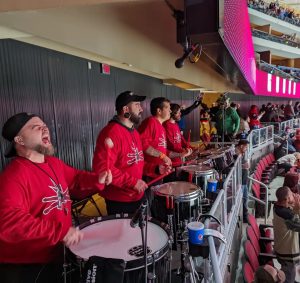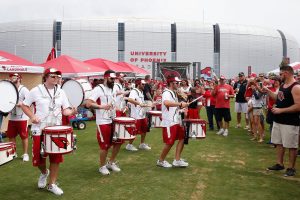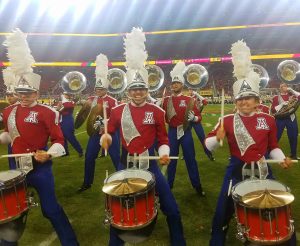- Slug: Sports-Drumlines in Sports, 1,487 words.
- 3 photos available
By Ryan Schwager
Cronkite News
PHOENIX – Whether it’s with “booms,” “thuds,” “thwacks” or “pops,” drumlines have a become a key piece of sports gameday entertainment.
Since the Notre Dame marching band’s first on-field performance in 1887, music and sports have long been intertwined. More than 134 years later, drumlines in particular have surfaced as one of the most popular ways for the arts to infiltrate the athletic world.
The highly charged sounds from a percussion ensemble can be found throughout Arizona, from the high-energy vibe delivered by Mesa-based BOOM! Percussion Entertainment at Suns and Coyotes games, to the Cardinals Drumline that is part of the NFL team’s gameday experience, to the offshoot collegiate contributions from marching bands at Arizona, Arizona State and Northern Arizona.
“We’re basically just cheerleaders with drums,” said Michael Richau, the owner and founder of BOOM!
It’s so much more. It’s the synchronous experience delivered by multiple drummers, or as the band in “Drumline,” Nick Cannon’s 2002 coming-of-age film, shouts, “One band, one sound!”
A rich history
On-field musical group performances are ever-changing. Originally, marching bands were created with militaristic practices and intentions, and performances were made to reflect recruits following a drill sergeant’s orders. Formations were straight lines, music was composed strictly for rhythmic repetition, and although sports fans loved what they saw, nothing from the entertainment perspective was unique to the team, venue and community that the organization represented.
Although military style music groups still exist today, several factors helped shift the way these groups entertain, including band performances from Historically Black Colleges and Universities, a popular move and a unique type of performance art.
Stomp was created in 1991 in the United Kingdom, and it quickly became popular for its style of drumming entertainment.
The group valued the performance as a whole over the music it played. Although its “use-everything-as-an-instrument” style was not initially popular, the amount of effort put into choreography and the blitzkrieg of “wow factors” helped the popularity grow.
Next came Charles Stone III’s 2002 movie “Drumline” featuring Cannon. The film highlights the fun and rowdy methods of HBCU bands and helped return drumlines to the spotlight.
The impact of HBCU can go back as far as the 1940s, and the high-stepping style and theatric dance routines showcased by Florida A&M University..
“Our first dance routine, I don’t know how or why it came about,” Dr. William Foster, FAMU’s band director emeritus, told the Birmingham Times. “It was to the tune of ‘Alexander’s Ragtime Band.’ We were just doing steps and high-knee lifts, and people thought that was the greatest thing on earth.”
By the 1960s, HBCU marching bands were attracting attention at places including Grambling, Southern and Tennessee State, with many eyes turning to their drumlines.
Going pro
Richau, the owner and founder of BOOM! Percussion Entertainment, loves his job. He is responsible for putting a small group of percussionists together to perform for professional sports teams in Arizona, including the Suns and Coyotes.
After spending 13 years as a music teacher at local schools, Richau started a trash can percussion group, much like Stomp, to perform at corporate events in convention centers, country clubs and more. Over time, Richau’s efforts and success allowed him to switch to BOOM! full time, and the company began to attract interest from sports teams.
“We got involved in the sports side of things later than other groups you may find,” Richau said. “We kind of worked backwards in the sense that we went after regular corporate businesses first, then got into the sports world later.”
While drumlines can be spotted throughout Arizona, their participation in sporting events is truly a national phenomenon.
The Pittsburgh Steeline is an example of one that start in the sports world and later added conventions, weddings and parties to their repertoire. Vince Wallace created the group in 2012, and thanks to persistently emailing and calling representatives of the Pittsburgh Steelers’ entertainment staff, they were able to go from playing in the parking lot before and after games to performing at halftime during an NFL preseason game at Heinz Field.
“To prepare for this, we borrowed drums from some already established local music organizations, recruited drummers, held auditions, printed some T-shirts and prepared music to play for this opening performance,” Wallace said. “It was well-received, and the fans seemed to really enjoy what we were doing. After this first game, we decided to continue performing the music we had learned outside of Heinz Field to entertain tailgating Steelers fans for other home games.”
Steelers fans appreciated the young music group’s performances, resulting in the Steelers making the Steeline a part of every home game and training camp since 2013. That includes performances pregame and postgame, enhancing the gameday experience of the fans inside and out of the stadium.
Wallace’s journey has come full circle since his time at a graduate school in Missouri. It was there where he had the idea of starting the Steeline. He met members of the drumlines for the Kansas City Chiefs and, at the time, the St. Louis Rams.
Keith Rousu, the director of the Seattle Seahawks’ Blue Thunder drumline and Seattle Sounders FC’s Sound Wave band, had a different experience.
“I was fortunate to hear of the desire to start a drumline in support of the Seattle Seahawks,” he said. “Originally I just wanted to play in the group when I was afforded the opportunity to interview for the director position, which I was offered and accepted. Five years after starting the Seahawks drumline, the opportunity to start a band for the Sounders FC was presented to me, which I jumped at.”
Philadelphia Eagles Drumline’s Andy Moffat has had an even different journey to his position of over 13 years.
“I am a lifelong Eagles fan living in Philly and come from a family of drummers,” Moffat said. “I was in the Indiana University of Pennsylvania Drumline in college which helped propel me into The Crossmen Drum & Bugle Corps. Thirteen years ago, I found out the Eagles were starting a Drumline so I auditioned and was lucky enough to grab a spot in the snareline with the team. A few short years later, I took over guiding the drumline mission.”
The Crossmen are part of Drum Corps International (DCI), which is considered to be the professional league for marching units. Moffat has used his experience at the highest level of music ensemble competition to help lead the Eagles Drumline today. He is responsible for booking gigs, auditioning, writing music and coordinating logistics on gamedays.
For Rousu, because the NFL and MLS are played very differently, with the NFL having more breaks in the action, he and his music groups, though playing in the same stadium, have learned to adapt to each game accordingly.
Brandon Estes, lead snare drummer and director of the Chicago Bears Drumline for over a decade and a former member of the Chicago Bulls “Stampede” Drumline, says choreography is a big part of enhancing the experience of Bears and Bulls fans.
“Much of our music includes choreography and dancing,” Estes said. “Choreography is integrated to keep each tune electric.”
“We believe the more visual we are, the more popular we will be,” Richau added.
Drumlines equal hard work
For every drumline in professional sports, gamedays are long and exhausting, with some key members of the group coming in up to six hours before kickoff, tipoff or puck drop. Still, they remain committed.
“Our mission is to add to the incredible gameday atmosphere in Philly and engage with as many Eagles fans as possible,” Moffat said.
Rousu added that “we want people to feel like they are truly part of the experience, and we love it when it becomes more than just the hockey, basketball, and football being played that day. “We know we’re making an impact when we see smiles on face.”
The struggles of the arts in the education system is not lost on this group.
High schools and colleges across the country are seeing their music programs slashed because of growing expenses. Many students are focused on other extracurricular activities, including sports.
It’s why those in drumlines believe their exposure is important to youth.
“Whenever a story like this can be told I’m so thankful to have the chance to help,” Moffatt said. “I love that a massive platform like the NFL has embraced the drumlines and almost every NFL team has one now. Talk about exposure for music. The fans absolutely love it and many teams actually put the drumline right on their sideline, or in the stands to play and keep the excitement all game long. That’s so huge.”
Richau acknowledge that “the Suns playoff run last season helped us, as well as the music industry in general, gain some more attention.
“The potential popularity of what we do perpetuates the arts, and it’s a great reminder to people that drumming is a fantastic form of entertainment.”
For more stories from Cronkite News, visit cronkitenews.azpbs.org.


